#it’s still too humid for me to be comfortable like my body cannot regulate still
Text
Man
#perfect storm of feels bad happening#it’s still too humid for me to be comfortable like my body cannot regulate still#and it’s a traumaversary (not just. the historical one lmao)#and I have a super long day with new and difficult students#(the kids are good just what they need is more challenging)#and my financial stuff still isn’t figured out#it’s just a Lot and I wish I could have a proper break at some point#i just want to not feel like I’m being hunted for sport for a little bit
4 notes
·
View notes
Text
Temperatures
As always, when you see one of these posts pop up you can head straight over to twirlynoodle.com/blog to see it properly formatted and with pictures. Tumblr didn't even take the crosspost last time so I don't know what's going on!
It’s all well and good to share photos of Antarctica – after all, it is a beautiful place, and we are predominantly a visual species. The photos can give you a sense of what it looks like, but not what it feels like. If people know anything about Antarctica, it’s that it’s cold. But how cold? And what kind of cold?
I cannot speak to the full range of Antarctic weather. I was down for exactly a month, in early summer, and aside from the first week, the weather was unusually calm and mild. To my great disappointment, I didn't see a single blizzard! But I did get enough to compare the feel of Antarctica with other places I have been, and I hope that by making those comparisons here, I will bring you a little closer to understanding quite literally what it feels like to be there.
Temperatures are misleading. A number can only give you an impression of what one might actually feel when one steps out the door. Humidity, sunshine, and wind are external factors that affect the perception of temperature; this can be further influenced by how much sleep or food you've had, BMI, resting metabolism, your accustomed climate, where you've just come from – so, 6°C can feel different from one day to the next, or to two different people standing side by side.
There are roughly two types of cold: dry and damp. The influential factor is water, because it takes a tremendous amount of energy to make water change temperature – this is why it takes so much power to boil a kettle, and why we bring hot water bottles to bed instead of hot gravel bottles. In dry environments, there is less water vapour in the air to suck up the heat coming off your body, so you get to keep more of it for yourself. It may be well below freezing, but you will feel the cold merely as a sensation on your skin, where it meets the air, and not something that goes right through you. Damp cold, because of the energy-hungry water in the air, feels a lot colder. It’s not enough merely to cover your skin, you need layers of fabrics that have moisture-repelling properties (wool is key; cotton is useless). Your precious body heat will leak out through any weak point in your clothing. Because of their different properties, dry air can be much colder than damp air and yet feel more comfortable. In my experience, damp cold is the worst when it’s above freezing, because below freezing the air can’t hold so much water. Damp climates, however, tend not to get much below freezing, so when people from damp climates imagine very cold temperatures, they imagine the insidious cold they know, only much much worse. It’s not necessarily like that.
Even the objective numerical value of a temperature presents a problem: my historical sources, and the United States of America, report temperatures in Fahrenheit, while the rest of the world operates in Celsius. Scientists prefer the metric system, but McMurdo is an American base, so it's functionally bilingual. I tend to think in Celsius, but as the historical record was in °F and I wanted to be able to compare what I was experiencing with what my guys experienced, I paid more attention to °F while I was down there. In this post, I will report actual temperatures in both, so you can look at whichever one you understand best.
When I left Britain in mid-October, we had been having a very mild autumn, after a hot summer. My hopes for hardening up a little on the way to Antarctica were dashed when Vancouver, though objectively colder, felt merely fresh and delightful, I assume because it was unseasonably dry. LA is always dry in the autumn and usually hot, so that was no surprise; Christchurch however was much warmer than expected, and because it wasn't as dry as LA, felt even hotter. After several days' delay there, I feared my blood was much too thin to be hurtled into ice and snow.
It is regulation to wear one's Extreme Cold Weather gear on the plane to McMurdo. Aware that I'd just had a fortnight of heat to thin my blood, and that they were just coming out of a cold snap down there, I was only too happy to take this precaution. When the plane landed, everyone piled on their balaclavas and tuques, and when the door opened, an icy-looking fog formed as our pent-up breaths met the cold air from outside. Here we go, I thought. As I approached the gangway I braced myself for the smart of cold air on exposed skin and the stiletto keenness as I inhaled, but . . .
. . . it was fine.
In fact, it was so fine that when I was allowed to change out of my ECW, I put on my street shoes, not even my cold-weather hiking boots. I knew dry cold from Utah and Alberta, but I was coming to understand that in an Antarctic context, “well it was -20, but it was a dry cold” isn't a joke, it's just a statement of fact. +6°C(42°F) would be miserable in damp Cambridge, but -6°C(21°F) was quite comfortable at McMurdo – if it wasn't windy, one could happily go about without a coat.
One always had a coat to hand, though, because the wind could turn up at any time, and it made a big difference. The first time I went to Cape Evans it was so mild as to be balmy – I was in snow pants because they were required for the snowmobile, but on top I stripped down to just my base layer and a medium-weight sweater, and was even a bit warm in that. It was -1°C/30°F, but I could happily have sat down to a picnic.
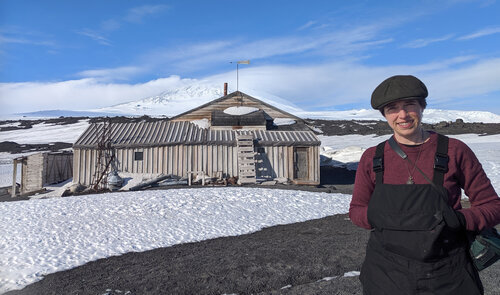
Before we left, I wanted to make a quick trip up Wind Vane Hill. I got hot climbing it, but while on top, a breeze kicked up, and before long I was wishing I hadn't left my jacket at the bottom. The reason I have my hands tucked in my snow pants bib in the above photo is because they were beginning to feel quite nippy. I always had a jacket with me after that, even if I cursed its dead weight the whole time. (It was usually my trenchcoat, not the big red parka, for this reason. I will go into more depth on clothing in a future post.)
A similar thing happened on my Basler flight. I'm afraid I don't know the actual temperatures where and when we landed – we were at the inland extremity of the Barrier, though, so everything I'd read told me it ought to be noticeably colder than McMurdo. It might well have been. But the only clue that it wasn't a perfectly warm summer day was that the slightest stir in the air breathed ice on my hands. It felt much the same at the much higher altitude site of CTAM. The interior of the continent is even drier than the coast: apparently, in the absence of wind and on a bright sunny day, this makes temperature barely perceptible at all.
A windless day is a vast exception in the case of Antarctic weather, though, and besides chilling a human body, the direction of the wind makes a big difference to the objective air temperature. A north wind, arriving from over the open sea, was comparatively mild. Most of the time, however, the wind was from the east to south, coming cold off the icy interior. This sends it funnelling through The Gap straight at Hut Point. The Hut Point Wind was infamous in the Heroic Age; even now it can be a pleasant day at the station, but one must remember to kit up just to walk around the corner to the Discovery Hut.
It did make for some great photos, though, because if the conditions were just right – which they were a few times in my month there – the wind would kick up some freshly fallen snow and things would look so very Antarctic. The funny thing was, on the days when it looked quintessentially polar, it was actually comparatively warm. The snow was so powdery that a fairly light wind could lift it, so it didn't have to be brutally windy to look brutally windy. The cold really sets in when a high pressure system stays in place for a while and keeps the air still; if there is turbulence, there is warmth, and if a weather system moves through – such as the kind that delivers snow – the temperature rises considerably. So in order for there to be fresh snow to blow around, there will have been a recent warm spell, whereas if it's starting to get cold again, the new snow will have compacted enough not to blow around. The strongest winds I encountered in Antarctica were at Cape Crozier, but you'd never guess it from my photos, which haven't a speck of drift. I am sure there are exceptions to this, but this was a dependable pattern in my time there.
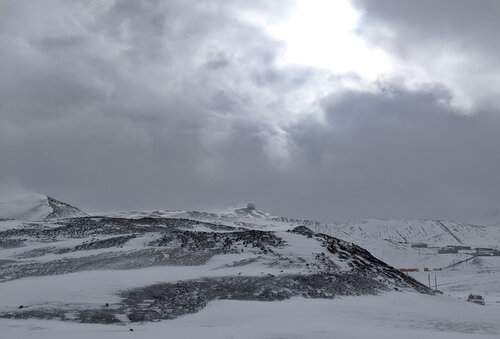
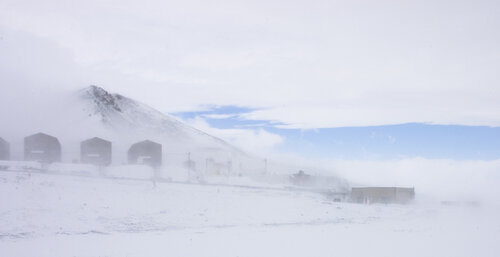
Above: two images of light snow blowing off just after a snowfall, when it was comparatively warm. Below: 30-knot winds at Cape Crozier, but you'd never guess.
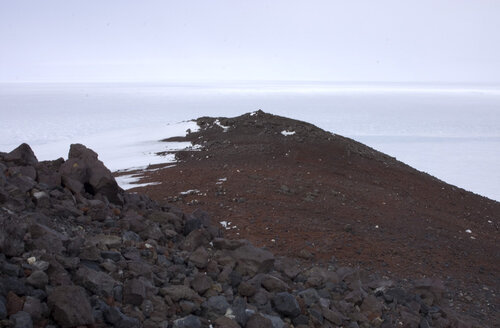
One of my oddest temperature memories was in one of those balmy drifty situations. I had been asked to give my history lecture over at Scott Base, and I was to wait for the Kiwi truck at a designated pickup point on the road coming over from The Gap. There are three official categories for weather in Antarctica: Condition 3 is when everything can operate as normal: it can be cold, it can be windy, but visibility is fine and the ordinary precautions will see you through. Condition 2 is when things are starting to get serious: drift and/or winds are reaching dangerous levels, extra precaution is necessary, and venturing outside is discouraged. Condition 1 is when everyone is required to stay indoors except on vital business as merely venturing outside is a life-threatening risk. During my month there it was always Condition 3, but within the hour of my pickup a Condition 2 had been declared on the Scott Base side of The Gap. My ride said she would be coming anyway, as she would be overwintering and needed the practice of driving in Condition 2, so I went up to meet her. I was hoping I would finally get a blast of Antarctica, but it gave me a surprise. For one, it was warm. And, yes, it was windy, but not desperately so, and the wind had a damp sweetness that, weirdly, made me think of swelling streams and crocuses. The Condition 2 had been called purely because of the drift, which was obscuring the road and therefore made driving more hazardous than usual. It was surreal to hear my driver checking in with her radio operator as if she were chasing tornadoes when it was really quite pleasant out.
My first few days at McMurdo were by far the coldest of my whole visit. When I first visited the Discovery Hut it was -18°C, or just below 0°F, and rather windy on the way back. That was when I learned that one can be feeling really quite cosy all over but one's outermost extremities can still suffer the cold – I distinctly remember wondering why my fingertips were tingling when I felt so warm, and a little while later my toes went numb and I had to stamp them back to life. The dryness, not sapping your core heat, can lure you into a false sense of security, and nab your digits while you're not looking.
After that, daily highs mostly hovered around the freezing point, and lows rarely dipped as low as -10°C/+14°F. This was really very mild – indeed, the people who'd been down since September could often be seen flitting about in t-shirts – and was an amusing irony for me personally. Twice in the past I'd visited Calgary in search of 'Antarctic' cold and hit, instead, a relatively mild spell; it turned out that in Antarctica I was getting exactly the same weather that I had thought un-Antarctic in Calgary. Not only was it the same weather on paper, but it felt exactly the same as well – the light, fresh kiss of frosty air on one's cheeks, surprising warmth in the sunshine but a breeze to keep you honest, and even the same granular texture to old snow. Altitude can give you the same feeling, as the thinner air cannot hold as much moisture as it can at lower levels, so if you've not been to the Prairies but have been on a ski holiday, you can use that as a reference point as well.
It is much harder to draw parallels with damper climates. At home in Cambridge, I have a sort of 'misery zone' between 4°-10°C (40°-50°F) where it's too cold to be warm, but not cold enough to be crisp, and the damp seems to seep through every layer to reach in and chill. As the thermometer plunges towards freezing and below, it is, ironically, more comfortable weather, because the colder the air is, the less moisture it can hold. In Britain I have sometimes found myself taking off layers as the mercury falls. When imagining Antarctica, people often extrapolate from their own experience of cold temperatures: If your base measure of cold is the 'misery zone' in a damp climate, such as Europe or the Eastern US, then you may think 'If 6°C feels like this, then -6° must feel that much worse' when in fact all the other factors at play can make it preferable. Even the cold days on my arrival at McMurdo were nicer, experientially, than a misty morning in deepest February back home. At one point, Cherry describes Antarctic summer weather as resembling a crisp sunny morning in September, and indeed from a British perspective Antarctica often felt more like a bright and breezy 13°C (55°F) than anything closer to freezing.
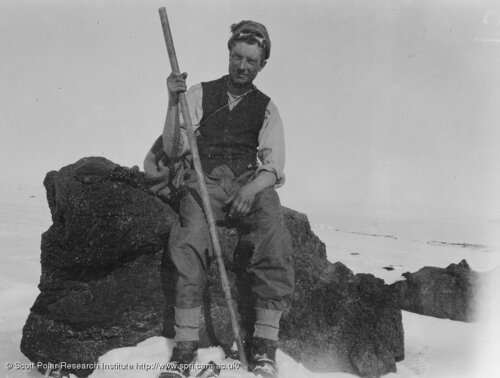
This gave me some perspective on the early explorers. If they had spent their lives on this chilly island, and then travelled to Antarctica over a chilly sea, they would be coming at it with all the assumptions one acquires from experience with humid cold. Finding not an amplification of your worst experiences, but instead a wonderland where the thermometer seemed to exist in a different reality – certainly the case when they arrived in midsummer – would encourage some overconfidence that we might consider reckless. Some, like Scott, had been down before and knew how deceptive the weather could be; his journals are full of chiding his team for not taking Antarctica seriously. But there were many who were new to it, and even after an Antarctic winter, sheltered as they were in an insulated hut by the sea, they did not fully grasp how dangerous things could get inland and how narrow the margins were. A breeze may be thrilling when it brings the truth of -10 to exposed skin warmed by the sun; when the truth is -40 it's instant frostbite. While I didn't get temperatures that low, my experience with higher ones can, I hope, help me imagine how that would go.
The dryness that made the cold so bearable granted me a reprieve from an opposing worry. Outside of Britain I generally find buildings overheated in the winter – I have to remind myself to pack light 'inside clothes' or else I suffocate. This is especially the case in the States, and McMurdo being an American base I foresaw having to strip five layers off and put them back on again every time I entered or exited a building. They may have been overheated, but I don't know – dry air saps the potency of heat as well as cold, so it was as comfortable to wear three layers as one, and that saved me a lot of time in the cloakroom. Thanks, Antarctica!
I had got so used to the nip in the air that I thought I'd be inured to cold for the rest of the winter, but once I was back on this cold damp North Atlantic island, the misery zone was as potent as ever. I may not have picked up thermoregulation superpowers in Antarctica, but I did come back with two secret weapons: merino wool base layers, and an utter disregard for my appearance so long as I was warm. I highly recommend both to anyone in a disagreeable climate.

103 notes
·
View notes
Text
Building a Solar Chicken Coop Heater
Do chickens need heat in winter? Is it worth the fire risk? A solar chicken coop heater could solve both problems to keep birds safe when temperatures plummet.
Each autumn, new chicken owners flock my direction when the first fall temperatures hit. Their chickens are cold! Should they put heat lamps or space heaters in the coop?
There are solid reasons to avoid using electric heat within a chicken coop.
Fire danger is the biggest reason. Even heated chicken waterers can cause devastating coop fires if they are set on combustible material. Those fires often happen at night, when it’s too late to save beloved birds by the time owners realize there is a problem.
Providing regular heat doesn’t allow chickens to acclimate to outside conditions. If the power goes out, so does the heat.
Chickens can handle a lot of cold. Those Icelandic chickens, the New Hampshires and Delawares? They evolved in areas with frigid winters, before people harnessed electricity.
What do I need in my Chicken Coop?
Download this FREE Guide from our chicken housing experts — chicken coop plans to ideas for nesting boxes. YES! I want this Free Report »
But there is one good reason to provide a little heat in the winter: Though the birds can withstand way below freezing by fluffing their feathers and huddling together, frostbite can kill tissue on feet and combs if too much humidity is present. A draft-free and well-ventilated coop allows heat to rise and carry moisture from bedding for chickens and to escape near the roof. Usually, deep litter and body temperatures create enough heat. Sometimes though, the coop could use a little help.
Like solar chicken coop lights, a solar heater can make coops more comfortable while remaining off-grid.
My mini-run that uses greenhouse dynamics to warm the coop.
Greenhouse-type Solar Chicken Coop Heaters
When I expanded my flock from five to 35 and built a new coop, I designed a mini-run with a greenhouse chamber. A strong frame jutted from the main coop, about knee-high, facing the sun. Hardware cloth wrapped the top and front. The leeward side housed the pop door, set in solid wood. I affixed a board inside that frame that chickens would have to walk around to enter the coop; this provided a windbreak.
During warm weather, hardware cloth sits bare and cool air wafts in from shaded ground. I wrap it with 6mil plastic when cold rains start to fall, stapling it to wooden boards and leaving the pop door free. Air enters through the pop door but cannot blow straight in; it moves around that board in the middle. Warmed by plastic, air enters the coop, lifts moisture, and exits through small gaps near the roof.
The same concept can be employed by wrapping larger runs in thick plastic, leaving gaps at the bottom so fresh air can enter. It also protects chickens from rain, snow, and harsh wind.
Craig’s Secret Solar Chicken Coop Heater
Craig Bergland, who runs the Facebook page Secret Solar Institute of Northern Nevada, is a genius with the sun’s power. He builds coffee roasters from old satellite dishes, covered in mirrors, pointing at a chamber turned by a solar-powered motor. One of his simplest, and most useful tools is a three-paneled cooker which folds to notebook size and can boil rice within three hours of full sun. Craig knows electricity or fossil fuels may run out during times of crisis or economic hardship. He teaches others how to build the three-paneled cooker and hopes to distribute them among the homeless.
When he suggested a solar chicken coop heater, I was intrigued. My birds do huddle a bit more than I like when winter plummets to single digits.
Here’s a cool fact about Craig: he won’t tell you to finance expensive solar panels. He wants low-cost solutions that remove items from the waste stream. His plans included amber glass bottles, empty metal canisters, and used cooking or motor oil.
We drafted a plan to enclose bottles of liquid inside a reflective, insulated box. Bottles would warm in the sun then we would close the lid, trapping heat and venting it into the coop. It works on the same concept as those barrels of water that gardeners place in off-grid greenhouses to regulate temperatures.
I purchased two sheets of inch-thick R-65 foam insulation with mylar backing. He emptied a few one-liter amber glass bottles “for science.” A friend working at an auto parts store provided old motor oil. While Craig acquired the dimensions and layout of my coop and built the insulated box, he gave me bottles of liquids to test in my freezer.
Inch-thick foam insulation.
Water holds heat longer, but would containers withstand a super-cold winter? Since Epsom salts have greater heat retention and can be drained into gardens, we ran tests to determine if the salts would keep water from freezing and breaking amber bottles. (The answer is no. Glass everywhere.)
We leaned toward oil, which takes very low temperatures to freeze and doesn’t expand the way water does.
“Oil heats up faster,” Craig explained, “but since it only weighs 90 percent of what water does it will not hold as much heat. However, this is a way to take castoff oil out of the waste stream and again, at some point, it could be reused and re-burned.” He also explained that oil will reach higher temperatures than water.
But how hot would bottles get before they burst?
Craig built the box in a long wedge shape, with the largest side opening to face the sun. He filled it with plastic and glass bottles, some with water and others with motor oil. I waited with a point-and-read thermometer until the sun blazed its hottest.
The bottles with oil reached 180 degrees midday in the summer. None burst, but we didn’t excuse the concern that it was possible.
Concerned about breakage and the toxicity of oil, Craig suggested old acetone or linseed oil cans for extreme temperature changes. Auto parts warehouses or paint stores could source free containers. Spray-painting them black would attract more heat. Craig prefers the metal cans because all plastic will eventually degrade in UV light and the heat will soften containers.
Venting heat into the coop is simple. It needs to escape through a side in the heating unit, travel through a very short tunnel, and enter the coop low enough to push humidity up. The tunnel can be made of aluminum cans, their tops and bottoms cut off, duct-taped together. Or it can be purchased from hardware stores.
Regarding pushing heat into the coop, Craig says, “A PV (solar) panel can power 12-volt fans to circulate warm air in daytime, and a small battery will run at night.” Often, the simple dynamic of heat rising up will pull warmth into the coop on its own.
While testing out my coop, I discovered two design flaws. First, unless the land is snowy or wet, dust soon covers the mylar. Not a problem, says Craig. It will still reflect heat. Second, chickens love standing in the heater. This is easily solved by stretching bird netting over the unit or covering the heating chamber with thick clear plastic. Cans would still heat through the plastic, but it would need to be pulled back for any repairs. Tacking foam boards to plywood increases its lifespan through weather, opening and closing, and fowl toenails.
Solar Chicken Coop Heaters for Pennies
“Here in sunny Nevada,” says Craig, “solar is no problem, but solar also works in other areas. There are reports of someone doing summer cooking in Antarctica at one time. And just because the sky is cloudy, that does not mean you will not get some solar heat again. Of course, adding reflectors to your thermal mass will greatly increase the amount of heat available to you throughout the night.”
The key here, says Craig, is to slow the rate of heat loss from containers through the night. Solar reflectors can be made from small mirrors, or even aluminum foil glued to cardboard, but insulation is the key to heat retention. If you build a heater and it cools off too soon before the sun rises, add more insulation and be sure a wooden box is built around the unit.
A few tips on building solar chicken coop heaters out of the cheapest materials:
Intersperse a few reused water bottles, filled with water, among the dark containers. This will fill in small, unused spaces and the plastic will not burst if you leave a little gap at the top.
If you’re going to use glass bottles, never fill them completely, as liquid expands as it heats. You can top off the bottle after it is hot, but leave at least an inch and a half of space. Only tighten down the lid after the bottle has gotten quite hot.
Setting glass bottles inside larger leak-proof containers will contain liquid and shards if bottles do break. These containers can simply be juice bottles with tops cut off.
Beyond Solar Chicken Coop Heaters?
It is possible that a simple coop heater could be adapted to provide warm temperatures for other livestock.
Craig’s design can be expanded to incorporate empty black feed or water barrels, set within a box lined with aluminum siding, venting into a barn. It can also cool livestock housing when used in reverse: the top stays open during the night, allowing cans or barrels to lose heat under the stars. The insulated top comes down before the sun can hit containers and cool air vents into barns or coops.
While a solar chicken coop heater may not change the world, says Craig, “It will help reduce some amount of our waste stream, may help keep our chickens a little happier on cold nights, and may give us a little feeling of satisfaction from having reused available resources.”
The heater, all closed up and insulated.
Have you tried using a solar chicken coop heater? Did you have success? Do you have any tips to share? Join in the comments below.
Building a Solar Chicken Coop Heater was originally posted by All About Chickens
0 notes